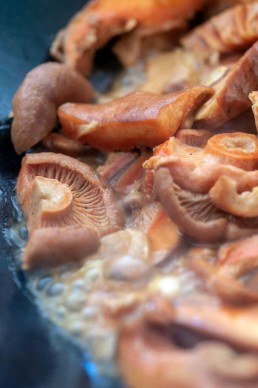With autumn in full force, a great diversity of fungi – some deadly and some desirable – are thrusting themselves through the earth.
With fungi being incredibly diverse, delicious (and sometimes deadly) a new book from CSIRO Publishing – Wild Mushrooming: A Guide for Foragers – delivers expert advice on best ways to go about finding, identifying and collecting the right mushrooms … as well as a mouth-watering selection of recipes to enjoy too. The book is co-authored by leading experts Alison Pouliot and Tom May and has been a collaborative project five years in the making. It includes sections on where, when, and how to find fungi and guides the forager in the identification of a selection of edible species.
Foraging for edible mushrooms is gaining popularity in Australia. With their earthy fragrances of wet forest, mushrooms truly capture the essence of the cooler months. However, those who fancy collecting a few mushies for dinner should take heed. Dangerously poisonous species lurk among the edibles that could land you in hospital or even in the grave. Telling them apart takes time and experience. Those foraging for edible fungi must be able to identify toxic lookalike species, especially the infamous death cap, Amanita phalloides.
Novice foragers should begin with more easily recognisable edible species such as the saffron milkcap, (Lactarius deliciosus), the slippery jack (Suillus luteus and S. granulatus) and the lawyer’s wig (Coprinus comatus). Each has its own particular features that need to be understood and recognised to make accurate identifications. Also, be aware that edible fungi cannot be identified from photos alone.
Saffron milkcaps (Lactarius deliciosus) grow in association with pines. Foragers in the region typically head to Pinus radiata plantations where they grow in great abundance.
The lawyer’s wig (Coprinus comatus) is so-called because of its tufted cap that resembles…you guessed it…a lawyer’s wig. Also known as an inkcap, this species produces copious quantities of black spores that resemble black ink as it deliquesces. They commonly pop up in lawns and disturbed areas such as track edges.
Slippery jacks are often found alongside saffron milk caps in pine plantations.
Keep in mind that dozens of native mammals such as wallabies and potoroos rely on fungi as food. Fungi are generally fairly indigestible to humans; hence we’re best just to eat them in small quantities. If you’re collecting edible fungi, remember only to take what you’ll eat that day and leave plenty for our native fauna.
Although the world is currently in lockdown, the fungi are running riot out there in the forest. The recent rains could mean we are in for a bumper mushroom season, but please forage within the constraints of the current isolation rules and remember that foraging is not permitted on public land.
Each year ecologist and environmental photographer, Alison Pouliot, runs forays and workshops to show people how to identify fungi and this year they are happening online.
Article revised March 2021
Words and Photography: © Alison Pouliot
Wild Mushrooming: A Guide for Foragers by Alison Pouliot & Tom May Released: Mar 2021 $49.99 PB 320 pp ISBN: 978148311736
Available from all good bookstores or order online at: publish.csiro.au/book/7894
Summer Deals


Tuki
This summer, we welcome you to experience a Tuki stay with this all-inclusive package valued at over $400 p/p.



Shizuka Ryokan Japanese Wellness Retreat & Bathhouse
FREE Japanese Bathing Ritual (worth $180)



Share this article
While You're Here
It’s Time to Say I Do (Finally!)
Boasting sublime settings, an abundance of accommodation with fine food and wine aplenty, it's no…
Budburst is Back
Want to discover one of Australia’s coolest wine regions? Then mark your calendars, as the annual…
Boutique wines in the Macedon Ranges
The Macedon Ranges Wine Region is well known for its cool climate, so it is not surprising that the…
Fermenting Country
Across our towns, villages, and countryside, is a close-knit community, quietly transforming raw…
Trentham to Daylesford Art Trail
Encourage your inner art critic this winter and explore the creative community that resides between…
Beyond the Daily Grind: Regional Coffee
The origins of coffee may be the stuff of legend, but today it is very much a part of our everyday…
Come Back to Life
Come and explore our beautiful region, it’s the perfect place to unwind, recharge and rejuvenate. The best bit, we’re only an hour or so from Melbourne.












